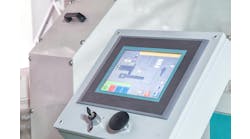Human-machine interfaces (HMIs) play an integral role in the manufacturing world that allows us, as humans, to interact with machines for a number of specific purposes. Whether we are utilizing a handheld control unit on a small deburring robot or an onboard CNC control on a multi–axis, multitasking machine tool, our ability to engage with a machine to carry out tasks is all dependent upon an HMI. Each of these machines, from robots to machining centers, has been developed, programmed and tested through some sort of an HMI. They remain and will continue to remain a crucial factor in the age of the machine that we are in now and on into the foreseeable future.
A number of developments have been made in the field of HMIs over the years. Early HMIs were basic and carried out simple, direct functions of a machine and introduced the ability for a machine to carry out the wishes of an operator or engineer. The most basic HMI is the light switch. You want the room to be lit up and no longer dark, but making a lightbulb glow on command is difficult without the ability of the light switch to allow the electricity to flow. So, you flip the switch from off to on, and, just like that, the light is on in the room. You, the human, have conveyed your wishes to the machine—the lightbulb—and now you have light.
Also read: The machine-of-any-flavor solution
The leap from basic switches and pushbutton controls that we have seen over the past few years has been greatly influenced by the advent of the Internet and the ability to collaboratively develop the technologies and next levels of HMIs in our industrial world. We went from basic single-purpose controls to fully interactive graphical open-sourced controls that are utilized in the most sophisticated systems in the world in just a few short years.
Even the term HMI is evolving into a newer term called “visualization.” Not only the actual control itself but also the way we understand and utilize and converse about HMIs is changing. We are able now to have whole systems under the control of an HMI and visualize how we are interacting with our machines and system while we collect and leverage the data to further enhance the productivity or reliability of a given system. Our HMIs today not only look down on their own machines to display specific information about it, but also across to other machines to collaborate with them and even up to networks and computers to utilize the data and increase efficiencies and learnings that are useful in the further development of our systems.
If we take the time to consider literally everything around us right now, the computer I am typing on, the pages you are reading, the glasses you may be looking through or the lunch you are eating or the desk you are sitting at, everything was at one point a part of a dynamic world of manufacturing. Machines helped us humans to create and develop our world. We are able to enjoy the benefits of the manufactured world around us that in some way or the other we were a part of. The machines that make it all happen, from space flight to a phone call, from the roads we drive on to the beds we sleep on, are now a major part of our developed world and almost all of them have had an HMI involved in the process.
The pace of the development of HMIs has been a bewildering race of technological advancements and software enhancement that have truly changed how business is conducted. The one constant we can reliably predict is change. Our industries are changing and evolving at a rapid pace, and it behooves us to invest in ourselves by learning how to utilize, to the best of our capability, the best practices and advancements that are now available in our particular fields.
It would seem unimaginable to me in my industry of CNC machining to see a customer who was unwilling to take on the newest technologies in the machining world. The ability, for example, to do live machine simulation on the machine control as the program is being written, will win out over unproven code every time. The competitive edge that is lost by refusing to learn the newest machine controls is a terrible waste of precious resources. Many folks have experienced great difficulties in hiring top talent for a variety of reasons. However, if we can buy the technologies available to us today that enhance the skill sets that we do have available, it seems like a practical thing and perhaps the only thing we can do to keep us ahead of the crowd. HMIs are a technological wonder, and, when used properly, we can leverage them for even greater opportunities and exciting new frontiers in manufacturing.





